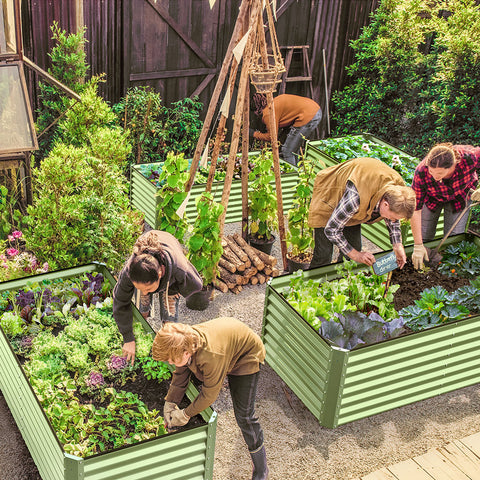When planning a raised garden, it can be difficult to know where to start. There are many factors that go into creating the perfect garden bed for the perfect yield. In this article, we will help you determine the best height for a successful raised garden bed.
Here are some questions to ask when deciding how deep to raise your fish:

What kind of plants do I want to grow?
Different plants have different root depths, and some plants need more vertical space than others. When planning your garden, be sure to take into account sun exposure, as well as the height of the plants you choose to grow.
Where will these raised beds go? What will they lie on?
Raising the surface under the bed will affect the optimal depth. In general, if the soil in your bed is able to exchange water with the soil below, you can choose a lighter bed. Depth is especially important if your lifting bed is on concrete or another surface that restricts water flow.
How could a bed be the most accessible?

The deeper the soil, the higher the fill in the soil and the higher the plants will be off the ground, which means less stooping when tending the garden. Spacious 2 foot high bed rows with aisles on either side for sitting, perfect for a wheelchair friendly garden plan.
Let's break them down one by one to help you plan the perfect raised garden.

Determine the depth of the garden bed according to the type of plant
The root system is the main part to keep in mind when planning the depth of your garden bed. Deep-rooted vegetables are generally not suitable for cultivation because they require a lot of space in all directions - and perhaps most importantly, deep into the soil. If you're hoping to grow, say, a type of corn, this may not be your best option. Fortunately, there are plenty of perfect candidates.
Herbs such as basil, cilantro and other low-leaf vegetables such as lettuce need only six inches of soil to grow. A 1-foot high bed is big enough to fit a salad garden in the box plan.
Carrots, radishes, and peppers grow more than 12 inches. Medium-rooted vegetables, such as kale, cucumbers and zucchini, need at least 18 inches. The 2-foot-tall nursery is perfect for growing these vegetables, as well as fruits that grow in bushes like blueberries, strawberries and raspberries.
Where to put your garden bed
A raised bed doesn't need to be deep to be effective, but the surface underneath your garden bed will affect the right depth.
In general, 8 inches is a good minimum depth for a raised garden bed. If there is a problem with drainage, or if the plants in the box are sensitive to too much water around the roots, the extra depth allows the water to penetrate naturally.
Raised bed plants can maintain more moisture for you if the soil can be placed on a liner of natural soil. When it rains, water naturally sinks deep into the soil. When the weather is hot or dry, evaporation and plant roots pull water back to the surface. Therefore, in wet weather, the raised bed soil can hold healthy moisture and not be submerged. A 1 - or 2-foot bed can be well drained with ground soil.

If the riverbed is located on concrete or other surfaces that block natural water flow and impede natural riparian and surface drainage, then installing a deeper riverbed can greatly improve drainage. Laying gravel or a porous growing medium under rich soil helps to balance the moisture content and prevent soil loss.
Make accessible garden beds
The two-foot raised bed is the perfect height for gardening from a seat or wheelchair without bending uncomfortably. An open plan with 2-foot raised beds, or rows of widely-spaced beds, can form the basis of a social gathering space for people living independently and assisted living, or be part of a functional and accessible community garden program.
Bottom line :1 foot vs. 2 feet
The best height for a raised bed depends on your imagination of where it is and what's inside. A pretty flower box or delicious herb garden is perfect for a durable 1-foot greedy bed.
For more room for plant roots to move around, some dazzling vertical flavor to your outdoor space, and better drainage options, a 2-foot raised bed is hard to beat. A little more fertile soil wouldn't hurt, and a little less curvature in the garden certainly wouldn't. If deep planting, or wheelchair accessibility is key, 2 feet deep is a must.
Why the enduring green space?
Durable Green Beds (based on the Farthwall Green Building System) use only 85% mineralized wood and 15% cement, making them one of the most environmentally friendly and healthy garden building materials available.









